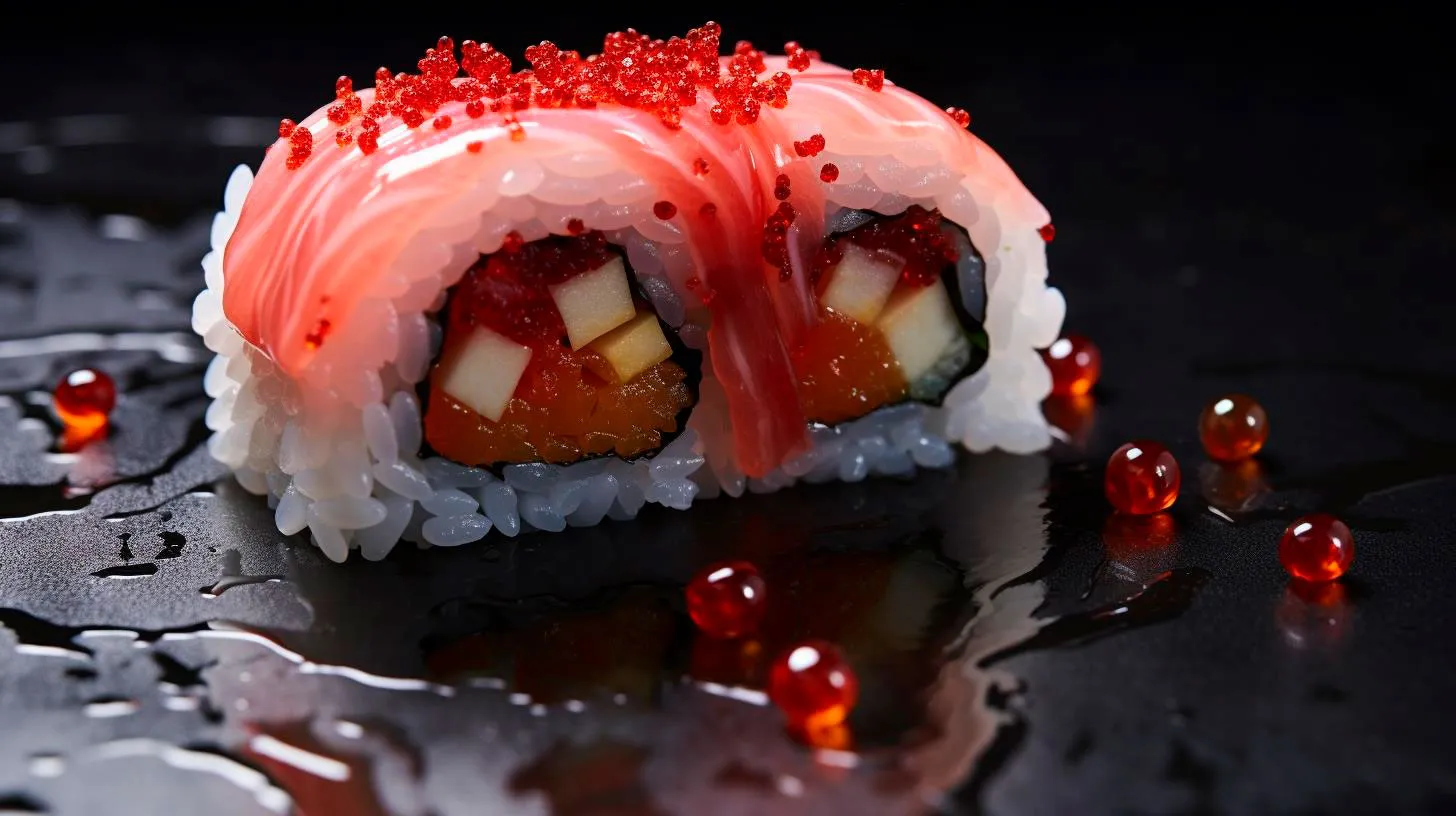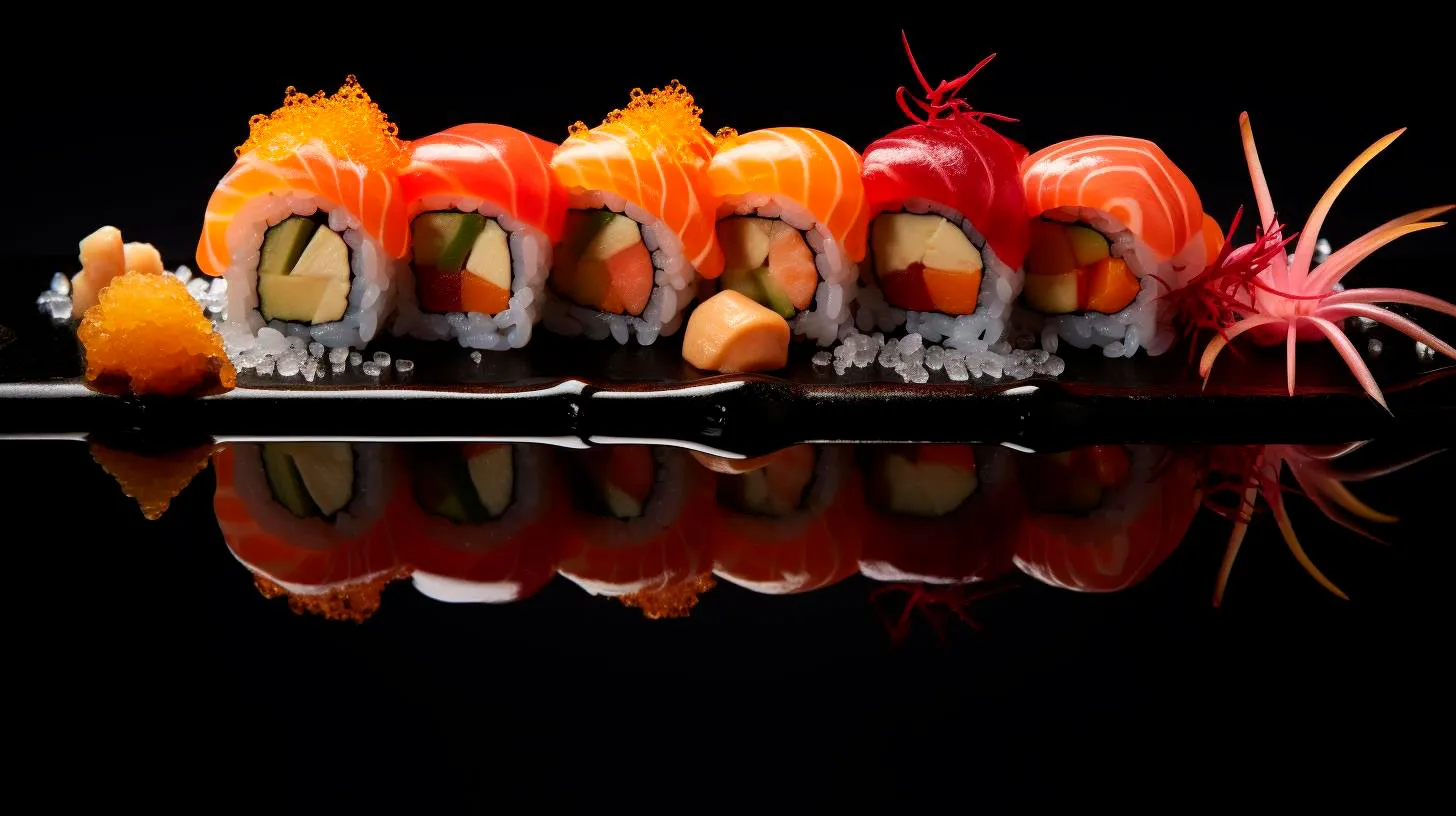Exploring Kyoto Oceanic Treasures: A Dive into Sushi Culture
In this article, we will take a deep dive into the sushi culture of Kyoto, exploring its rich history, unique ingredients, and the art of sushi-making.
The History of Sushi in Kyoto
Kyoto, with its rich cultural heritage and status as the former capital of Japan, has always been at the forefront of artistic expressions, including culinary arts. Sushi, originally a preservation technique to ferment fish, was introduced to Kyoto during the Heian period (794-1185). Influenced by the nobility and aristocratic culture of the time, Kyoto-style sushi, or Kyo-zushi, adopted a sophisticated and refined approach, emphasizing aesthetics and the delicate balance of flavors.
Kyo-zushi is known for its use of vinegared rice, or shari, which is subtle yet flavorsome. The sushi toppings, or neta, are carefully selected and prepared to enhance the natural flavors of the fish. Kyoto’s sushi chefs pride themselves on their skillful knife work, which ensures the perfect balance and presentation of each piece of sushi.
The Unique Ingredients of Kyoto Sushi
One of the defining characteristics of Kyoto sushi is the use of local and seasonal ingredients. Being located inland, far from the pristine coastal waters, Kyoto has had to use its creativity to procure the finest oceanic treasures despite its geographical limitations. The result is an array of unique sushi ingredients that are sourced from nearby regions or even further afield.
Some of the essential ingredients found in Kyoto sushi include:
- Ayu: A type of freshwater fish that is endemic to Japan and commonly found in Kyoto’s rivers. Ayu’s delicate flavor and texture make it a prized ingredient in sushi.
- Sabazushi: Kyoto’s famous mackerel sushi, marinated in vinegar and pressed with rice in a wooden box. This traditional sushi has been enjoyed in Kyoto for centuries.
- Matsutake Mushroom: A seasonal delicacy cherished in Kyoto. Its distinct aroma and flavor add a unique touch to sushi preparations during the autumn months.
- Kamo Eggplant: A local specialty, Kamo eggplant is often pickled and used as a topping for sushi. Its slightly bitter taste complements the other flavors in a sushi roll.
The Art of Sushi Making in Kyoto
Creating sushi in Kyoto is not merely a culinary endeavor; it is an art form that requires years of training and skill. The sushi chefs in Kyoto, known as itamae, dedicate their lives to mastering the craft, ensuring every piece of sushi they create is a masterpiece of taste and visual appeal.
The intricate techniques used by Kyoto chefs elevate the sushi experience. The precise slicing of fish and the expert molding of rice, combined with the graceful movements of the itamae, create an unforgettable dining experience. In Kyoto, sushi chefs value simplicity and minimalism while focusing on enhancing the natural flavors of the ingredients.
Key Takeaways from Kyoto Sushi Culture
As we explore Kyoto’s oceanic treasures and dive into its sushi culture, here are some key takeaways:
- Refined Elegance: Kyoto-style sushi embodies sophistication and elegance, reflecting the cultural heritage of the city.
- Seasonal Delights: The use of local and seasonal ingredients ensures a fresh and diverse dining experience.
- The Presentation Matters: The meticulous presentation of each sushi piece elevates the overall dining experience to an art form.
- The Balance of Flavors: Kyoto sushi pays great attention to the delicate balance of flavors, allowing the natural tastes of the ingredients to shine.
- An Artistic Journey: Enjoying sushi in Kyoto is not just a gastronomic delight; it is an immersive journey through centuries of tradition and culture.
As you embark on your gastronomic adventure in Kyoto, don’t miss the opportunity to explore the oceanic treasures that sushi culture has to offer. Discover the refined elegance, artistic mastery, and unique flavors that make Kyoto sushi a remarkable experience. Remember, sushi is not just a meal; it is a cultural exploration that connects you with a rich heritage.
Sushi and Beyond Kyoto Seafood Delicacies
In this article, we will explore the fascinating world of sushi in Kyoto, unraveling its secrets, and showcasing its unique features and advantages.
The Essence of Sushi in Kyoto
Sushi is a centuries-old Japanese dish that has gained worldwide popularity for its delicate flavors, beautiful presentation, and meticulous craftsmanship. But in Kyoto, sushi takes on a whole new level of refinement and sophistication. Renowned for its emphasis on tradition, Kyoto is home to numerous sushi establishments that strive to preserve the spirit and authenticity of this beloved cuisine.
Key Takeaways:
- Kyoto is known for its traditional and authentic sushi
- Sushi in Kyoto embraces the essence of Japanese culture and craftsmanship
- Attention to detail and respect for tradition are paramount in sushi-making
The Freshest Catch from the Sea
One of the secrets behind Kyoto’s exceptional sushi lies in the quality and freshness of its seafood. With its close proximity to the Sea of Japan and the Pacific Ocean, the city has access to an abundant variety of fish and shellfish. Sushi chefs in Kyoto prioritize using locally sourced ingredients, ensuring that each piece of sushi showcases the natural flavors of the sea.
Key Takeaways:
- Kyoto benefits from being surrounded by a rich source of fresh seafood
- Local ingredients are used in sushi-making to highlight their natural flavors
- Freshness is a top priority for sushi chefs in Kyoto
Exquisite Flavors and Artistic Presentation
Every sushi dish in Kyoto is a work of art. With meticulous attention to detail and a focus on aesthetic beauty, sushi chefs in Kyoto create visually stunning masterpieces. Each piece is carefully crafted, ensuring a perfect balance of flavors and textures. From the silky smoothness of sashimi to the subtle tanginess of pickled vegetables, every bite is a delight for the senses.
Key Takeaways:
- Sushi in Kyoto showcases an exquisite balance of flavors and textures
- Visual presentation is an important aspect of sushi-making in Kyoto
- Sashimi and pickled vegetables add unique dimensions to the overall sushi experience
Cultural Significance and Rituals
Sushi is not just about food in Kyoto; it is a profound cultural experience. Traditional sushi bars in Kyoto may have a serene atmosphere, where every aspect of the meal is carefully orchestrated. From the moment you enter the restaurant to the final bite, you will witness rituals that have been passed down through generations. Whether it’s the respectful interaction between the chef and the customers or the meticulous preparation of each dish, every moment is steeped in tradition.
Key Takeaways:
- Sushi in Kyoto is not merely a meal but a culturally significant experience
- Traditional sushi bars in Kyoto follow sacred rituals and customs
- Respect for tradition and attention to detail are evident in every aspect of the dining experience
Appreciating the Artistry of Sushi
When enjoying sushi in Kyoto, it’s important to appreciate the artistry behind each piece. From the delicate knife skills of the chefs to the subtle seasoning of rice, every step is meticulously executed. Take your time to savor each bite, understanding the dedication and craftsmanship that goes into creating these edible masterpieces.
Key Takeaways:
- Sushi-making in Kyoto requires exceptional knife skills and attention to detail
- Understanding and appreciating the artistry behind each piece enhances the dining experience
- Savoring sushi in Kyoto allows you to truly connect with the craftsmanship involved
In Conclusion
Kyoto, with its deep-rooted culinary traditions, offers a sushi experience that is unmatched. From the freshest catch to the meticulous craftmanship, every aspect of sushi-making in Kyoto is an ode to the rich cultural heritage of Japan. So, the next time you find yourself in this historic city, indulge in the gastronomic splendor that awaits you and embark on an unforgettable sushi journey.
Unraveling the Secrets of Kyoto Hidden Seafood Gems
In this article, we’ll dive into the secrets of Kyoto’s hidden seafood scene, uncovering its unique offerings and exploring the exquisite flavors that await.
Discovering Kyoto’s Hidden Seafood Delights
1. Kyoto’s Freshwater Bounty:
- Kyoto is renowned for its freshwater fisheries, where rivers and streams provide an abundant supply of freshwater fish and shellfish.
- Due to the proximity, these freshwater gems can be delivered promptly to restaurants, ensuring the utmost freshness in every bite.
- Don’t miss the chance to savor Kyoto’s specialties like Ayu (sweetfish), Hamo (pike conger eel), and Unagi (freshwater eel).
2. Unique Seafood Varieties:
- Despite being an inland city, Kyoto’s connections to coastal regions allow for the availability of a wide variety of seafood.
- Delicacies such as snow crab, abalone, and sea urchin can be found in select restaurants, providing a taste of the ocean without leaving the city.
- Indulge in Kyoto’s specialty seafood dishes like Kani Nabe (crab hot pot) or Uni Sushi (sea urchin sushi) for an unforgettable dining experience.
The Rich Culinary Heritage of Kyoto
1. The Art of Kaiseki Cuisine:
- Kyoto is famous for Kaiseki, a traditional multi-course dining experience that exemplifies the region’s culinary prowess.
- With a focus on seasonal and locally sourced ingredients, Kaiseki masters incorporate seafood to create harmonious and visually stunning dishes.
- Immerse yourself in the exquisite world of Kaiseki by trying Unagi Kabayaki (grilled eel) or Saba Sushi (mackerel sushi).
2. A Legacy of Traditional Sushi:
- Kyoto’s sushi traditions trace back to the Edo period, showcasing a unique style that differs from the more commonly known Tokyo-style.
- The Kyoto-style sushi emphasizes milder flavors, highlighting the natural taste and texture of the seafood.
- Sample Kyoto-style sushi with its signature vinegared rice and artisanal toppings like Seki Saba (Kyoto mackerel) or Kuruma Ebi (Japanese tiger prawn).
Making the Most of Your Seafood Journey in Kyoto
1. Exploring the Nishiki Market:
- Known as “Kyoto’s Kitchen,” the centuries-old Nishiki Market offers an array of fresh seafood, ensuring an unforgettable market-to-table experience.
- Stroll through the bustling market and let the colorful displays of seafood inspire you to try local specialties like Yudofu (tofu hot pot with seafood) or Kaki Fry (breaded oysters).
- Engage with the friendly vendors to learn about the seafood sourcing and preparation methods, enhancing your gastronomic adventure.
2. Hidden Seafood Restaurants:
- While exploring Kyoto, venture off the beaten path to discover hidden seafood restaurants tucked away in narrow alleyways.
- These lesser-known establishments often offer an intimate dining experience where you can savor Kyoto’s seafood delicacies in a tranquil setting.
- Ask locals or do some research to find hidden gems like small sushiya or izakayas known for their exceptional seafood dishes.
With its unique blend of traditional flavors and hidden seafood gems, Kyoto invites you to embark on a culinary journey that will both satisfy your taste buds and nurture a deeper appreciation for Japanese cuisine. From freshwater delicacies to oceanic treasures, the city’s seafood scene promises an unforgettable dining experience that should not be missed.
Unforgettable Flavors: Savouring Kyoto’s Distinctive Seafood Delicacies
A Celebration of Freshness
One of the key aspects that sets Kyoto’s seafood apart is its unparalleled freshness. Thanks to the city’s central location, surrounded by mountains and with easy access to bountiful oceans, Kyoto is perfectly situated to offer some of the freshest seafood in Japan. Local fishermen bring in their catch daily, ensuring that the seafood you savor in Kyoto is as fresh as it can be.
Key takeaways:
- Kyoto’s central location ensures access to fresh seafood.
- Local fishermen provide a daily supply of fresh catch.
Unique Fishing Techniques
Kyoto’s fishermen employ traditional and sustainable fishing techniques, passed down through generations. This approach not only helps preserve the balance of marine ecosystems but also ensures the highest quality seafood reaches your plate. From line fishing to net fishing, each method used in Kyoto is selected with utmost care to minimize environmental impact and maintain the delicate balance of the sea.
Key takeaways:
- Sustainable fishing techniques prioritize environmental preservation.
- Traditional methods ensure superior quality seafood.
A Diverse Seafood Selection
When exploring Kyoto’s culinary landscape, you’ll soon discover the wide array of seafood delicacies that await you. From delicate sashimi to hearty hot pots, there is something for everyone. One must-try is the “Kaiseki” dining experience, a traditional multi-course meal that showcases the best of Kyoto’s seasonal ingredients, including fresh seafood.
Key takeaways:
- Kyoto offers a diverse range of seafood delicacies.
- Kaiseki dining allows you to savor the essence of Kyoto’s seafood.
Signature Dishes
When it comes to must-try seafood dishes in Kyoto, there are a few that stand out from the crowd. One such delicacy is “Kani Misosukushi,” a specialty dish made with fresh, succulent snow crabs. The creamy miso sauce enhances the natural sweetness of the crab meat, making it an unforgettable culinary experience. Another must-try is “Katsuo no Tataki,” a dish featuring lightly seared bonito fish, which is tender and full of umami flavors.
Key takeaways:
- “Kani Misosukushi” is a must-try dish made with fresh snow crabs.
- “Katsuo no Tataki” offers a unique seared bonito fish experience.
Health Benefits of Kyoto Seafood
Kyoto’s seafood not only delights the palate but also offers numerous health benefits. Rich in omega-3 fatty acids, vitamins, and minerals, seafood is known to promote heart health, improve brain function, and support overall well-being. By indulging in Kyoto’s seafood delicacies, you can enjoy nutritious meals while savoring the flavors unique to this picturesque city.
Key takeaways:
- Kyoto’s seafood is packed with omega-3 fatty acids and vital nutrients.
- Seafood supports heart health and brain function.
In Conclusion
Savoring Kyoto’s distinctive seafood delicacies is an unforgettable experience that combines tradition, freshness, and exceptional flavors. From the meticulous fishing techniques to the diverse array of dishes, Kyoto truly captures the essence of Japanese seafood cuisine. Whether you are a seafood enthusiast or an adventurous food lover, Kyoto’s culinary offerings will leave a lasting impression, keeping you longing to return for more.
From Tuna to Uni: A Gastronomic Journey through Kyoto Sushi Varieties
From the finest cuts of tuna to the velvety texture of uni (sea urchin), the city offers a wide range of sushi varieties that are sure to delight even the most discerning palates.
So, join us on a journey through the different sushi varieties that Kyoto has to offer, as we explore the unique flavors, preparation techniques, and cultural significance behind each dish.
1. Nigiri Sushi
Nigiri sushi is perhaps the most well-known and widely enjoyed type of sushi worldwide. In Kyoto, the art of preparing nigiri sushi is taken to new heights, with skilled sushi chefs meticulously hand-crafting each piece. Whether it’s a perfectly sliced piece of fatty tuna (toro), melt-in-your-mouth salmon (sake), or buttery uni, the simplicity and elegance of nigiri sushi will leave you craving for more.
Key Features:
- Minimalist design with a single slice of fish or seafood on a mound of vinegared rice.
- Exquisite attention to detail in shaping and forming each piece.
Advantages:
- Allows for the freshness of the seafood to shine through.
- Each piece can be enjoyed individually, focusing on the unique flavor of the fish or seafood.
2. Maki Sushi
If you’re more inclined towards sushi rolls, Kyoto offers a variety of maki sushi that will tickle your taste buds. From the classic California roll to inventive creations using local ingredients, maki sushi provides a delightful combination of flavors and textures in each bite.
Key Features:
- Seaweed wrapped around a filling of rice, fish, vegetables, or a combination.
- Can be customized with different toppings or sauces.
Advantages:
- Perfect for those who prefer a bit more variety in their sushi.
- Offers a satisfying balance of flavors and textures in one bite.
3. Chirashi Sushi
For a visually stunning and flavor-packed sushi experience, Chirashi sushi is a must-try dish in Kyoto. Chirashi sushi, also known as scattered sushi, is a bowl of vinegared rice topped with an assortment of colorful and fresh ingredients, including sashimi, vegetables, and pickles.
Key Features:
- Artfully arranged toppings create a vibrant and appetizing presentation.
- Ingredients may vary depending on seasonality and chef’s creativity.
Advantages:
- Provides a wide range of flavors and textures in every spoonful.
- Showcases the versatility and creativity of Kyoto’s sushi chefs.
Key Takeaways
As you embark on a gastronomic journey through Kyoto’s sushi varieties, keep in mind these key takeaways:
- Kyoto offers a diverse range of sushi varieties, each with its own unique flavors and presentation.
- Sushi in Kyoto is prepared with utmost precision and attention to detail, showcasing the mastery of the sushi chefs.
- Whether you prefer the simplicity of nigiri sushi, the variety of maki sushi, or the artful arrangement of chirashi sushi, Kyoto has something to satisfy every sushi lover’s palate.
So, next time you find yourself in Kyoto, be sure to embark on your own gastronomic journey and savor the tantalizing flavors of the city’s rich sushi culture.



